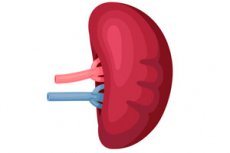New publications
Targeting the Spleen: A New Way to Deliver Drugs for Lupus
Last reviewed: 23.08.2025

All iLive content is medically reviewed or fact checked to ensure as much factual accuracy as possible.
We have strict sourcing guidelines and only link to reputable media sites, academic research institutions and, whenever possible, medically peer reviewed studies. Note that the numbers in parentheses ([1], [2], etc.) are clickable links to these studies.
If you feel that any of our content is inaccurate, out-of-date, or otherwise questionable, please select it and press Ctrl + Enter.

The University of Houston has developed a concept for spleen-specific drug delivery for systemic lupus erythematosus (SLE). The team of bioengineer Tianfu Wu received a $1 million Impact Award from the U.S. Department of Defense to create lipid nanoparticles that are “targeted” to the spleen: the particles are modified with mannose so that they bind to mannose receptors on immune cells in the spleen - B cells, plasmacytoid dendritic cells, and macrophages. The idea is to modulate the immune response right where it flares up, rather than “dousing” the entire body with systemic immunosuppression.
Background of the study
Systemic lupus erythematosus (SLE) is a multisystem autoimmune disease based on autoactivated B cells and the interferon (IFN) response, especially IFN-α production by plasmacytoid dendritic cells (pDC). These axes - B-cell and interferon - are currently the main therapeutic targets (belimumab against B-cell activation, anifrolumab against the IFN-α receptor), but their effectiveness is limited by the heterogeneity of the disease and the cost of systemic immunosuppression.
The key "node" of pathogenesis is the spleen: follicles and marginal zone are concentrated here, spontaneous autoimmune germinal centers are formed, pDC accumulate and "feeding" of pathological B-cell responses occurs. Therefore, the spleen is not just an "observer" organ, but an active stage of autoantibody generation, from where systemic effects are launched. A pinpoint effect on cells in the spleen is theoretically capable of extinguishing the "spark" of the disease before it flares up throughout the body.
Technologically, such a targeted approach is made possible by advances in lipid nanoparticles (LNPs) and targeting of the mannose receptor (MR/CD206), which is expressed on macrophages and dendritic cells. Modification of particles with mannose enhances their uptake by CD206-bearing cells, and changes in lipid composition help to “shift” the tropism of LNPs towards the spleen. Mannose-targeted conjugates/nanoparticles have already been shown to effectively deliver RNA cargo to macrophages/DCs, and the inclusion of specific lipids enhances splenic deposition.
Against this backdrop, a team at the University of Houston has proposed and received funding for the first spleen-specific delivery system for SLE: mannose-modified LNPs targeting splenic B cells, pDCs, and macrophages. The idea is to modulate the immune response locally, reducing the incidence of flares with less risk of systemic side effects compared to broad immunosuppression or total B-cell depletion. If the concept is validated in preclinical and early phase studies, it will be a step toward organ-specific strategies for treating autoimmune diseases.
Why is this important?
Current SLE treatment regimens are often a compromise between disease control and the cost of infections, cytopenias, organ toxicity, and cumulative damage. The spleen is the "guardian of the bloodstream," a filter, and a site for lymphocytes, making it critical to lupus pathogenesis. Shifting the focus to the source organ has the potential to reduce systemic side effects and better manage flares.
How it should work
- Platform: lipid nanoparticles (LNPs), well known from mRNA vaccines.
- Targeting: Mannose on the particle surface for targeted binding to mannose receptors in the spleen.
- Cellular targets: B cells, pDCs and macrophages are key drivers of the autoimmune response in SLE.
- The goal: selective immunomodulation in the spleen instead of total immunosuppression or complete “demolition” of B cells.
How does the approach differ from standard therapy?
- Organ specificity versus systemic effects: less “strain damage” to the rest of the immune system.
- Fine-tuning the response instead of a “kill switch”: the goal is to dampen pathological activity while preserving the protective functions of B cells.
- New development logic: taking into account that the same molecular target can behave differently in different organs (spleen vs. “end organs” - kidney, heart, CNS).
What can this give to patients?
- Fewer infections and side effects compared to broad immunosuppression.
- Better control of flares by targeting the "node" of the pathological immune response.
- Personalization of treatment: different “entry portals” for drugs depending on where the inflammation is most active in a particular patient.
What is not clear yet
- Preclinical development is ahead: biodistribution, dose dependence and safety in animals and in early phases in humans need to be proven.
- On-target monitoring: tags/scanners are needed to confirm accumulation in the spleen and action on specific cell populations.
- Scaling and regulatory pathway: reproducibility of LNP production, stability of mannose targeting, performance criteria for clinical trials.
What's next?
According to the authors, this could be the first specifically designed spleen targeting for SLE. The next steps are preclinical testing, validation of the “targeting,” and preparation for early clinical phases. If the concept works, it could open the door to organ-specific strategies for other autoimmune diseases where key events occur in lymphoid organs.
Source: University of Houston - “University of Houston Professor Creates New Drug Delivery System to Tackle Lupus” (August 18, 2025).
